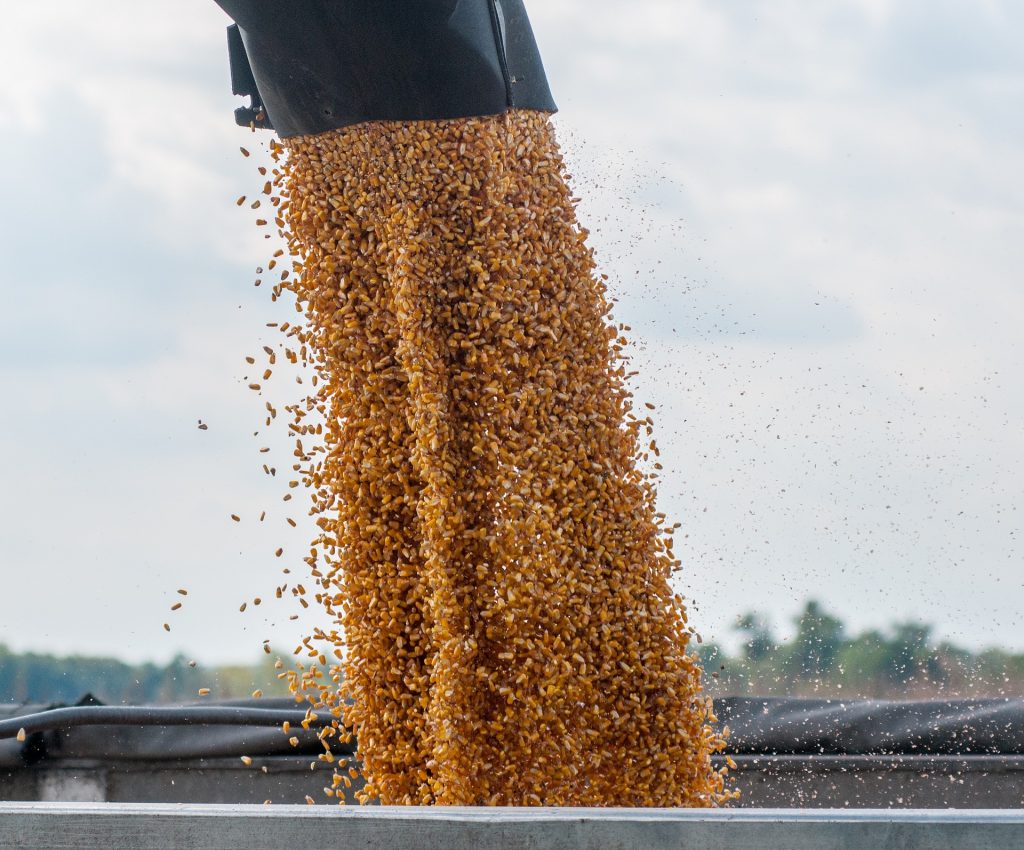
What to feed deer instead of corn?
Sure, corn is cheap deer feed.
But is it really the best feed for deer?
It turns out it might not be.
Luckily there are some GREAT alternatives to corn.
Not only will these alternatives attract more deer, but they will help the deer will grow bigger and healthier.
If you are just looking for a quick suggestion, Purina Antler Advantage is an excellent choice.
Corn is the most popular feed for deer but there are many reasons you may want to feed them something other than corn.
Deer thrive when their food intake includes a variety of sources, simulating a natural environment with diverse plant food sources. Luckily there are some good alternatives that offer advantages over corn.
The suggestions in this article are primarily for feeding whitetail but you can also apply them to mule and blacktail deer.
Why Feed Deer?
Supplemental feeding isn’t about fattening up the deer you hunt.
It is about conservation and supporting your deer population.
Supplemental feeding can be especially important for diminished habitats. This happens for many reasons but the result is the same; inadequate amounts natural food sources for deer.
There is a difference between baiting and supplemental feeding. Supplemental feeding is to help deer when food is scarce and conditions are harsh. This means the winter months after the rut. Baiting aims to attract more deer during the months of August-November (hunting season).
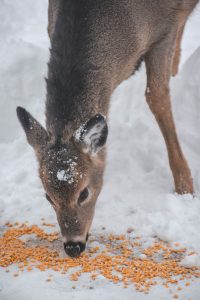
Reasons to Feed Deer Something Other Than Corn
Do deer eat corn?
Yes, deer love to eat corn and it is fairly inexpensive.
Hunters looking for cheap deer feed often resort to corn.
But, the most compelling reason to feed deer something other than corn is because the nutrient content of corn is not ideal for deer.
The MSU DeerLab suggests the best protein content for good healthy antler development is around 16% protein. This is why deer will even resort to eating fish when they must.
Unfortunately corn feed is 8-9% protein, falling well short of the suggested content.
The other downfall of corn is that it’s mineral content is generally lower than most other types of common feed grains.
Is corn bad for deer?
No, this doesn’t mean you shouldn’t use corn at all. Corn can work well as a supplement to other types of feed. One of the great things about corn is that deer love it and you should use this to your advantage. Mixing corn with the alternatives listed below is a great way to attract deer to your feed and provides variety in their diet.
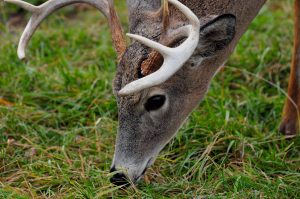
What is the best deer feed?
As mentioned above, the best protein content for deer feed is around 16%. To get the best deer antler growth requires the bucks are well nourished.
Many of their natural food sources such as nuts, grass, weeds, fruits, and twigs provide a variety of carbohydrates, proteins and other nutrients. When thinking about what to feed deer, you want to attempt at providing some diversification.
The list of other potential feeds for deer below attempts to provide that diversity. The benefits of each are discussed below.
Risks Associated with Feeding Deer
There are always risks associated with supplemental feeding for wild animals. The risks include chronic wasting disease, bovine tuberculosis, and overpopulation, incorrect nutrient requirements.
If you are serious about starting a supplemental feed program you should consult a local wildlife biologist. Make sure to check your local regulations before planning any supplemental feeding or baiting. Many states do not allow you to feed or bait due to the risks discussed above.
One of the major concerns with feeding deer especially during winter is acidosis. Acidosis happens when deer eat too much of a high carbohydrate source like corn without allowing time for their digestive system to adapt. Acidosis can cause death. For this reason, the Michigan DNR recommends using less than 25% corn.
If you have deer in your backyard, think twice before feeding them something like bread. The risks of CWD are real and hurting the deer population across the United States.
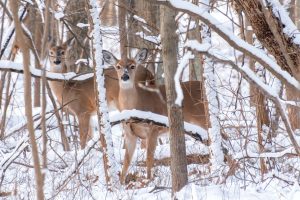
It is important to be very cautious about feeding deer corn during winter. Their digestive system adapts this time of year to eat high protein, high fat, high fiber. For more information on the dangers of incorrect feed during the winter, checkout this article by bonecollector.com.
During summer, spring, and fall deer are better able to utilize feed sources with higher carbohydrate content like corn. It is still best to mix this with a high protein source.
What to Feed Deer Instead of Corn
Consider a Food Plot
Deer food plots are a great way to provide deer with supplemental feed. They are safe, effective, and legal no matter where you live. This is the number one preferred way to supplement deer.
Here are two quality plot seeds by BioLogic on Amazon: New Zealand Maximum and Spring Peas.
- BIOLOGIC NEW ZEALAND MAXIMUM: 2.25 lb. bag of New Zealand Brassicas (Plants 1/4 Acre). Blend matures at different rates to ensure highly palatable forage for the entire life of the plot
- NUTRITIONAL VALUE: Averages 36% Crude Protein and over 80% TDN which promotes antler growth and overall herd health. Will grow in all soil types pending adequate soil moisture is available
- PRIMARY USAGE: Palatability increases as plants mature. Best late season through winter. However, may be consumed as fast as it grows. Produces anywhere from 10-15 tons of forage production per acre
- BIOLOGIC SPRING PROTEIN PEAS: 20 lb. bag of annual warm season food plot for whitetail deer. Designed to provide maximum nutrition for your deer herd through the critical growing months
- NUTRITIONAL VALUE: Summer legumes range from 20-25% protein. Blend can significantly help whitetail antler growth and fawn rearing/production. Protein peas are drought and browse-tolerant
- PRIMARY USAGE: Spring protein peas have two different succession rates, iron and clay pea is desired as soon as it germs and mung bean tends to be more palatable once it flowers later in the summer
For more information about food plots, checkout our article on Easy Food Plots for Deer or visit the NDA website.
- English (Publication Language)
- 310 Pages - 01/07/2026 (Publication Date) - QDMA Quality Deer Management Association (Publisher)
Woody Browse
If you have trees and brush you can trim on your property, pruning them can be a great way to supplement deer feed. This has the advantage of providing them with food they naturally eat. During the winter, deer have adapted to consume high fiber, high protein twigs and brush. Deer also use these branches to communicate.

Formulated Deer Feed Mixes
- Purina Advanced Rumen Support System with seaweed-derived calcium to support rumen health by helping Manage rumen pH
- Prebiotic to aid beneficial rumen microbial populations for optimal digestion
- Power-packed nutritional package of protein and energy with ideal amounts and ratios of vitamins and minerals
This is an excellent choice for supplemental feed. Purina has formulated their feeds to meet proper deer nutritional ratios. It has a high protein content and ideal amounts of vitamins and minerals.
- Concentrated Deer Bait - Turns your everyday corn/feed into a super attractant for white tailed deer
- Strong and Sweet Aroma - Draw more bucks from miles away or change deer travel patterns
- Large Coverage Area - Each bag of concentrate treats 300 lbs of corn/feed (50 lbs per 2 oz scoop)
Buck Blitz works incredibly well as an attractant. It is probably too expensive to use as a regular feed but you can use it as part of a mix or during that time of year you want to lure those bucks in. Just make sure to check your state regulations first.
Oats
Oats are high in fiber, have good protein content (12%), and are easily digestible. The Michigan DNR claims “After formulated deer food mixtures, oats are preferred over all other supplemental foods.”
Rice Bran
Rice bran feed provides a good amount of protein (13%) and is similar to oats in nutrient breakdown. It is recommended you use rice bran as part of a mix to feed deer and not all by itself.
Alfalfa
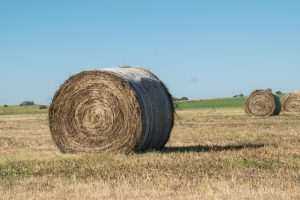
Alfalfa bales are another commonly used feed for deer. They are a much better option than corn or hay. Alfalfa is easily digestible but will not come cheap. It has a high protein content of 15-20%, depending on the cut. Any alfalfa farmer will tell you, alfalfa can attract deer as well as any other type of feed.
Soybeans
You should always mix soybeans with other types of deer feed due to the high fat and protein content. The protein content is roughly 40% so you can mix it with corn to increase the total protein intake. A mixture of 50% corn and 50% soybeans is common although limiting corn to 25% is better. You can use oats or rice bran for the rest of the mixture.
Creep Feed
Farmers use creep feed for calves as a source of supplemental nutrition. It is a mixture of corn, oats, alfalfa, barley, soybeans, and minerals. If you decide to use calf creep try a variant around 15% protein. Creep feed is a great inexpensive way to feed deer that provides them with the nutrients they need.
Inexpensive Way to Feed Deer
With the price of everything going up everyday, feeding deer can get expensive. Feeding the deer in your backyard probably isn’t your top priority when you have other bills to pay. So, how can we use the knowledge above to feed deer a healthy diet while doing so on a budget?

Cheap Deer Feed
Deer feeding doesn’t have to be complicated.
Based on current market prices, the best inexpensive way to feed deer is to buy cracked corn, oats, and soybeans in bulk. These can usually be purchased in bulk for a discount at a local feed mill or animal feed store.
The high carbohydrate content of the corn will balance well with the high protein and fat content of the soybeans. And, as we know from above, oats are the best deer feed after formulated deer food mixes.
Frequently Asked Questions
What type of feeder should I use a deer feeder?
A good deer feeder for someone just starting is this 6.5 gallon feeder by Moultrie. The setup is straightforward as it uses AA batteries. Fill the feeder and select the number of times per day you want to feeder to dispense. It comes with a locking lid to keep the feed dry and animals out.
- 6.5-gal. metal bucket with 40 lbs. capacity
- Quick-Lock modular technology allows the kit and hopper to connect with no tools necessary
- Directional shroud designed to cast feed in a 30-degree range; ideal for use along roads, pond, trails, or food plots when 360-degree casting isn’t needed
How much deer feed do you need per deer?
A common rule of thumb is 1 feeder per 25 deer, each deer consuming 1-2lbs. Of feed per day.
What is the best deer attractant to mix with corn?
Corn by itself should attract deer. If corn alone isn’t doing the trick, add a small amount of molasses to the corn.
Another good option is to use vanilla extract. You can use it on your own or add a small amount to corn.
Deer aren’t coming to my feeder, what can I do?
As mentioned above, spread some molasses in the brush near your feeder. This will act as an attractant and bring deer to the area.
Do’s and Don’ts When Feeding Deer
- There may be some debate, but shelled and cracked corn both seem okay. There was a study that found cracked corn for deer is more digestible.
- Make sure to use a feeder that keeps the feed covered and dry. This will prevent the feed from getting moldy. If the feed becomes moldy, it is best to not feed it to them.
- If you setup a mineral block, make sure to do so near a water source. Having it near a water source will tie it to their natural routine of needing water.
Where can you learn more about feeding deer?
- Your state’s fish and game department
- NDA Website
- Consult a local wildlife biologist
Summary of What to Feed Deer Other Than Corn
The goal of this article is to help highlight why only corn might not be the best deer feed. After reading everything above you should now see there are some great alternatives. Whether you are feeding deer in your backyard or trying to attract deer for hunting, the tips provided will work.
If you want to feed deer, keep the following in mind:
- The best food for deer is made up of about 16% protein. This will maximize antler growth and overall health.
- Feeding deer corn will not produce the best results, corn is only about 9% protein.
- The best deer feed is a mixture of sources that mimic their natural diet and provide enough protein.
- An inexpensive way to feed deer is to mix corn with oats and soybeans and consider a food plot.





